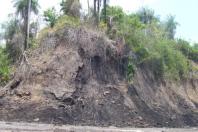Oil shale is a rock made up largely of ancient algae; you can burn it to release energy, or process it to produce diesel fuel. Unlike shale oil, which is oil locked in rock, oil shale is a rock that turns into oil, when heated to very high temperatures.
The United States has vast quantities it has hardly touched, but it’s the tiny former Soviet republic of Estonia, population 1.3 million, that has cornered the market.
As one energy trader said, “Estonia has put itself on the map of the world with oil shale. In this particular technology we’re good, we’re the masters.”
Estonia relies on oil shale for fully 4/5 of its electricity needs, making it the rare Eastern European country that is not dependent on Russian natural gas. Its power companies are among the world leaders in oil shale technology.
But mining the rock has gouged huge holes in this heavily forested country, and the industry is not without its detractors. “The bloody stone doesn’t burn. You have to put as much energy in to get it out again,” Valdur Lahtvee of the Stockholm Environment Institute’s Tallinn center told Britain’s The Telegraph newspaper last year.
Oil shale does produce oil -- when it’s heated to 5,000 degrees Fahrenheit -- but the total heat, and thus energy, it produces is only around half as much as the same amount of coal, according to a U.S. Geological Service report. It also leaves a bigger carbon footprint than conventional oil, natural gas, or shale gas, according to the Stockholm Environment Institute.
Those are some of the reasons its share of Estonia’s energy budget will shrink in the coming years. Estonia’s long-term energy strategy sets a 50 percent limit on the contribution of any single energy source to the nation’s power use, and oil shale currently supplies 84 percent of power, Lahtvee told Oilprice.com. He believes renewables -- primarily biomass and wind -- can supply all of the country’s power and heat by 2030, given enough investment.
As the current open-pit mines become exhausted, the rock will also become more expensive to extract as operations are forced to move underground, according to the USGS report, which also notes the problem of serious air and ground-water pollution and leaching of toxic compounds from spoil piles –one of which has been converted into a ski hill.
Even proponents of oil shale admit it is profitable to export only when conventional oil is high and EU emissions credits are cheap, as they are now. Estonia hopes to add value to oil shale by such routes as processing it to make high-quality diesel fuel. State-owned Eesti Energia, the country’s largest power company, is also working on ways to cut ash and sulfur emissions, making the fuel less environmentally damaging.
Add to all these reasons the increasing burden of complying with the European Union’s stringent climate change rules and it’s not hard to understand why Eesti Energia, or Enefit as it’s known abroad, is looking to export its technology and know-how. Earlier this month, the Jordanian government announced that it would soon sign a deal worth $2.1 billion for construction of the country’s first oil shale-fueled power plant. Enefit will join with Malaysian and Jordanian partners on the 30-year contract, which had been held up by a disagreement on the price the government is contracted to pay for electricity.
Jordan aims to increase domestic energy production to 60 percent by 2020. It currently imports 96 percent of energy needs at a cost of nearly $3 billion a year. Oil shale is a natural for Jordan because shale reserves underlie 60 percent of its surface, making it one of the five most shale-endowed countries, according to Enefit.
After Jordan, Enefit has its eyes on a much, much bigger play. There could be as much oil in the oil shale deposits of the Green River Formation beneath Colorado, Utah, and Wyoming than the rest of the world’s proven reserves of conventional oil combined, the U.S. Government Accountability Office estimates. About half of that oil is thought to be recoverable. But the image of mineshafts dug into thousands of acres of big-sky Western high desert has American environmentalists worried.
At the moment, however, the costs of mining shale and extracting the oil exceed the potential selling price, ABC reported in 2012. Getting the oil out of oil shale involves heating the rock to very high temperatures either on the surface, as the Estonians do, or using still-unproven underground heaters. These operations could require huge amounts of water, pollute water sources, and produce clouds of dust, environmentalists warn.
These concerns have kept oil shale exploration in the Green River Formation to a minimum. No company has yet produced commercial quantities of oil here, although a Utah company, Red Leaf Resources, claims it may soon do so.
Red Leaf’s demonstration project aims to extract 300,000 barrels of oil, a fraction of the 2.6 billion barrels Enefit believes can be extracted from land it owns or controls in Utah.
“So long as oil stays above $80 a barrel, this will be profitable,” Estonia’s then-Economy Minister Juhan Parts told The Telegraph last year.
What will happen to the price of oil if the estimated 1.5 trillion barrels of recoverable Green River oil start to hit the market? It could blow away companies much bigger than Enefit.
By Ky Krauthamer of Oilprice.com
http://oilprice.com/Energy/Energy-General/Estonia-Pioneers-the-Next-Big-...


